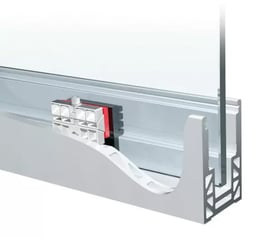What is dry glazing?
Dry glazing requires no wetwork, and is utilized more often for interior projects. In most cases, dry glazing systems use extruded rubber or plastic components, along with aluminum or stainless steel fixing mechanisms.

Like wet glazing, dry glazing has its own set of advantages and disadvantages.
Pros:
- Installation is faster and simpler than wet glazing, as it doesn’t require exterior access or waiting for cement to cure
- Many dry glaze systems don’t require special tools — for some, all you need is an Allen wrench
- Installation isn’t weather-dependent
- No mess — there’s no mixing and pouring of expansion cement, and no running of cement on sloped mounting surfaces
- Labor tends to be less expensive
Cons:
- Less watertight, requires the addition of “weep holes” and provisions for drainage when used in exposed locations
- Parts may be more expensive
- More “walk,” or movement of the glass
- May be difficult to adjust for plumb
Conclusion
As you plan your glass railing project, you’ll need to determine whether wet glaze or dry glaze is the best option for your installation. Consider the details of your particular pursuit to determine the method that’s right for you.
Factors to keep in mind include:
- Size of project
- Resources (e.g. availability and experience level of workers)
- Desired timeline
- Whether the installation is interior or exterior
- Site conditions such as substrate, slope, or structure
- Typical weather in your area (e.g. humidity and/or precipitation)
- Building codes in your area
- Budget
The best way to ensure you’re using the correct method for your project is to talk to an expert at Morse Industries. We’ve been helping clients select products for difficult jobs in railing for almost 40 years. Our priority is supporting you — our team will work with you from start to finish, giving you the support you need to ensure that the job is done right.
CTA: Have questions about choosing between wet or dry glaze? Contact us.